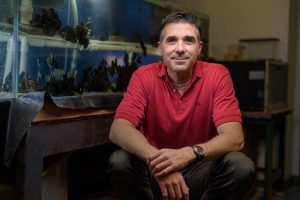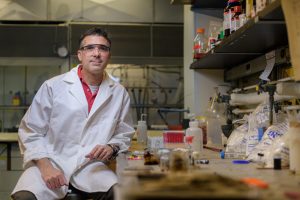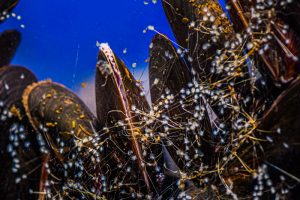
By Brittany Steff
Don’t look now, but you’re surrounded. Really. Within arm’s reach – probably even touching you – are troublesome, sticky, potentially even toxic, substances. Bad for the planet, permanent, maybe even bad for your health. They’re in your shoes, in your phone, in your laptop, lurking in the folds of envelopes, on books, in the chair you’re sitting in, the flooring beneath your feet, and in uncountable other objects in your house, office and everyday world.
They are adhesives. Vital to daily life, nearly unnoticeable, but also deeply problematic. They can be toxic and are usually permanent. Purdue University chemists are studying shellfish to develop new, safer and more sustainable adhesives for uses ranging from bandages and medical applications to clothing, household items, electronics and more.
Humans have been trying to stick things to other things for millennia. But shellfish have been doing it for eons longer. And they are far better at it than humans. Which is why Purdue chemists got to wondering: Why don’t we just use whatever they’re using? Anyone who has ever tried to unstick a barnacle from a rock knows that it’s nearly impossible.
That success is something Jonathan Wilker, a Purdue professor of chemistry and materials engineering, and his lab are hoping to learn from — and build on.
Shellfish And Saltwater: Underwater Adhesion That Works
“We start by looking at animals that make adhesives,” Wilker said. “We’re still working to understand the fundamentals of how animals like mussels and oysters do what they do, how the chemistry and engineering work together. We are even seeing how the environment around them and the surface they’re sticking to influences what they do.”
Critters such as barnacles, mussels and oysters live in places where they are continually battered by waves and wind and pried at by potential predators. Their very lives depend on being able to cling to rocks and their neighboring shellfish.
Sutures, screws and staples are all widely used to close wounds, bind tissues and set bones, but they are all very damaging and extremely painful. If doctors had a chemical adhesive that they could use instead, healing would increase and collateral damage would decrease. The body, however, is a challenging environment for adhesives: wet and constantly in motion. A lot like the sea.

Scientists in Wilker’s lab — which includes two postdoctoral researchers, five graduate students, four undergraduate researchers and 1,000 shellfish — study how shellfish create materials, what components of the adhesives play active roles in bonding and test new synthetic and biomimetic glues to determine their efficacy, feasibility and performance. They are building on that understanding to develop adhesives that work underwater, are stronger, more sustainable, made from food products and that can be un-stuck when needed.
We’re making adhesives with new functionalities” Wilker said. “We can add in new chemical groups to target all sorts of properties, be that wet bonding, rubber-like flexibility or the ability to bond and then de-bond. One of our systems can even be stronger than what the animals make underwater. In that case, we are using chemistry that is inspired by the shellfish but, overall, our system is a simplification of what the animals produce.”
Gunning For New Glue: Making Adhesives Nontoxic, Reversible
Every product in the glue aisle at the hardware store has a downside. Many are toxic. Particle board, laminate flooring and hardwood plywood are all held together with formaldehyde-based resins, which can be carcinogenic. Additionally, many adhesives are permanent. There is no way to dissolve the bond when a product is at the end of its life, which often prevents the components from being recycled.
“Almost every common glue is petroleum-based and not degradable,” Wilker said. “When your laptops or cell phones, shoes or furniture are no longer needed, most of them go straight to a landfill. Even materials like cardboard often do not get recycled because of the adhesives.”
Many glues are nearly permanent, a factor many people have discovered when trying to remove the gumminess from a sticker or price tag from a product — or, more unfortunately, from a car window where a child sat. Being able to reverse stickiness at will would give humans more control over their environment.
Increasing the sustainability and the functionality of adhesives can improve human life in a myriad of ways: by limiting exposure to harmful chemicals, by making healing more comfortable, and by making products more sustainable and more recyclable to preserve resources and the planet. Wilker’s lab is working to make glues out of bio-based and even food-based compounds.
Adhesion is a rapidly evolving field with huge potential. It’s a field in which Wilker is a recognized expert, thanks to a stray thread of curiosity encountered in the ocean.

“The core ideas in our lab come from spending time underwater,” Wilker said. “I was SCUBA diving, saw shellfish sticking to rocks and thought, ‘I wonder how that works?’ When I got back into the lab, I was surprised to learn about what remained unknown. There are so many exciting possibilities and applications to pursue if we can figure it all out.”
As both a professor of chemistry in the College of Science and a professor of materials engineering, Wilker bridges the worlds of science and engineering in his efforts to tap the natural world for innovative solutions to adhesion problems. The Office of Naval Research and the National Science Foundation help fund his research.
Wilker has worked with the Purdue Research Foundation Office of Technology Commercialization to apply for patents on his adhesives from the U.S. Patent and Trademark Office. He is starting to make them commercially available through commercial ventures including a startup, Mussel Polymers Inc.
Editor’s Note: Brittany Staff is a science writer at Perdue University
June 2021




